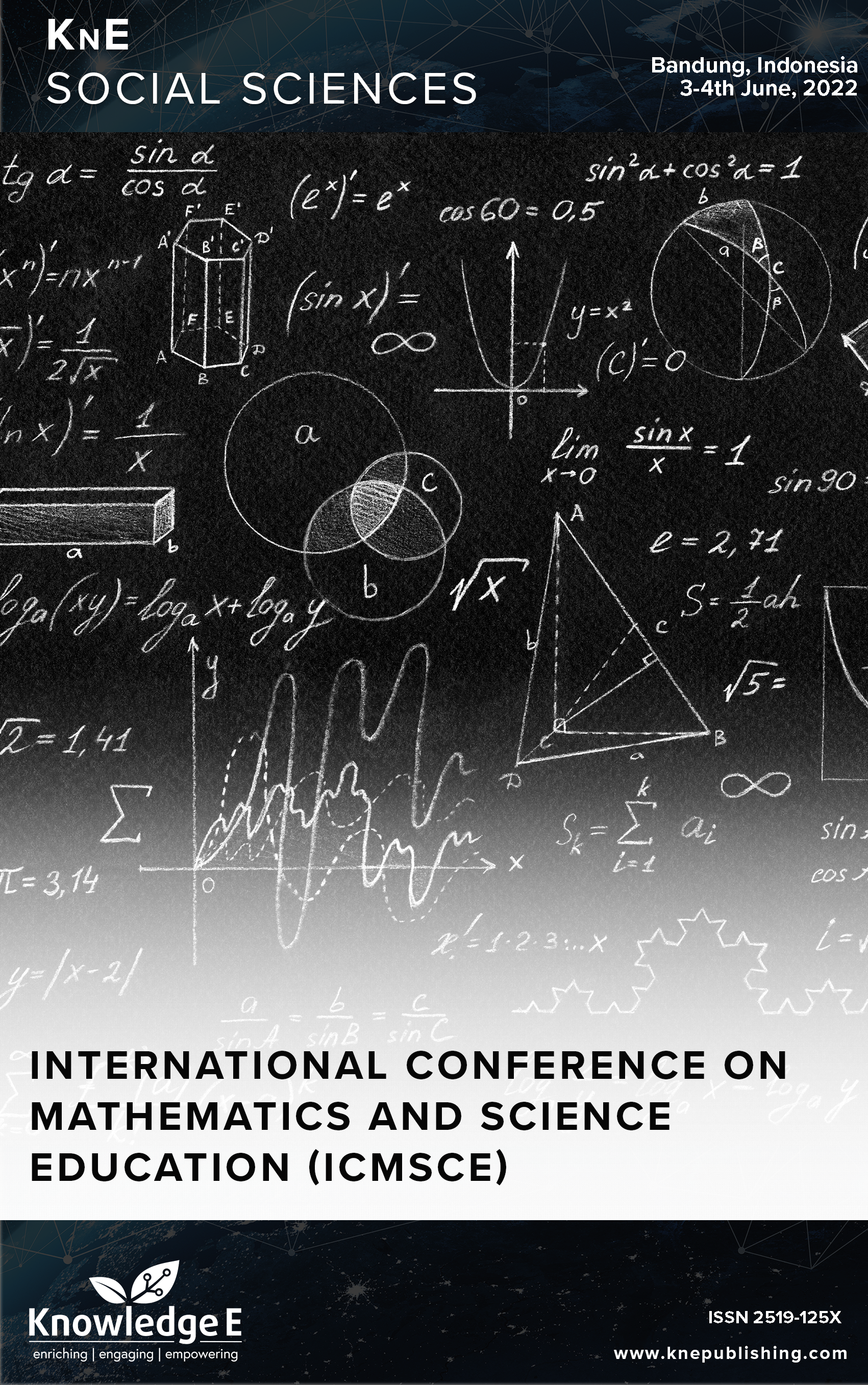The Development of Chemical Representations-Oriented Virtual Laboratory for Teaching Electrolysis in Chemistry Classes
DOI:
https://doi.org/10.18502/kss.v9i8.15565Abstract
This study aimed to describe the development of a chemical representation-oriented virtual laboratory. It produced a learning media application which could be used in electrolysis study materials. The study described the analysis phase and the design and development phase. It also analyzed the results of limited tests towards the product. The study showed that the virtual laboratory features a colorful, attractive design and interactivity. The virtual laboratory can be potentially used as a learning media in chemistry learning on electrolysis concepts.
Keywords: chemical, virtual laboratory, electrolysis
References
Sari S, Destianti SA, Irwansyah FS, Subarkah CZ, Aulawi H, Ramdhani MA. Solubility equilibrium learning supported by PhET-SS. Journal of Physics: Conference Series. 2019;1157(4). https://doi.org/10.1088/1742-6596/1157/4/042010. DOI: https://doi.org/10.1088/1742-6596/1157/4/042010
Sari S, Ferawati SA, Farida I, Sobandi O, Kariadinata R. Online based performance assessment for general chemistry laboratory. IOP Conference Series: Materials Science and Engineering. 2018;434(1). https://doi.org/10.1088/1757-899X/434/1/012190. DOI: https://doi.org/10.1088/1757-899X/434/1/012190
Gunawan A. Harjono, H. Sahidu, and L. Herayanti, “Virtual laboratory to improve students’ problem-solving skills on electricity concept,”. Jurnal Pendidikan IPA Indonesia. 2017;6(1):41–8. DOI: https://doi.org/10.15294/jpii.v6i2.9481
Sofi’ah S, Fisika J, Matematika F, Ilmu D, Alam P. Pengembangan laboratorium virtual berbasis VRML (virtual reallity modelling language) pada materi teori kinetik gas. Upej. 2017;6(1).
Rizal A, Adam RI, S. Susilawati S. Sistem kelas virtual dan pengelolaan pembelajaran berbasis 3-dimensional virtual world. Jurnal Edukasi dan Penelitian Informatika ( JEPIN). 2018;4(2):132. https://doi.org/10.26418/jp.v4i2.27449. DOI: https://doi.org/10.26418/jp.v4i2.27449
Bowen AS, Reid DR, Koretsky M. Development of interactive virtual laboratories to help students learn difficult concepts in thermodynamics. ASEE Annual Conference and Exposition, Conference Proceedings. 2014;49(4):229-238. DOI: https://doi.org/10.18260/1-2--20317
Potkonjak V, Gardner M, Callaghan V, Mattila P, Guetl C, Petrovic VM, et al. Virtual laboratories for education in science, technology, and engineering: A review. Comput Educ. 2016;95:309–27. DOI: https://doi.org/10.1016/j.compedu.2016.02.002
Kumari P, Kaur P. A survey of fault tolerance in cloud computing. J King Saud Univ Comput Inf Sci. 2021;33(10):1159–76. DOI: https://doi.org/10.1016/j.jksuci.2018.09.021
Vincenti G, Bucciero A, de Carvalho CV. E-Learning, e-education, and online training: first international conference, eleot 2014 bethesda, MD, USA, September 18–20, 2014 Revised Selected Papers. Lecture Notes of the Institute for Computer Sciences, Social-Informatics and Telecommunications Engineering, LNICST. 2016;138(April). https://doi.org/10.1007/978-3-319-13293-8. DOI: https://doi.org/10.1007/978-3-319-13293-8
Asiksoy G, Islek D. The impact of the virtual laboratory on students’ attitudes in a general physics laboratory. International Journal of Online Engineering. 2017;13(4):20–8. DOI: https://doi.org/10.3991/ijoe.v13i04.6811
G. Hermansyah and Herayanti Lovy, Pengaruh penggunaan laboratorium virtual terhadap. Jurnal Pendidikan Fisika dan Teknologi. 2015;1(2):2407–6902.
Emda A. Laboratorium sebagai sarana pembelajaran kimia dalam meningkatkan pengetahuan dan ketrampilan kerja ilmiah. Lantanida Journal. 2017;2(2):218. DOI: https://doi.org/10.22373/lj.v2i2.1409
Irwansyah FS, Ramdani I, Farida I. The development of an Augmented Reality (AR) technology-based learning media in metal structure concept. Ideas for 21st Century Education. Routledge; 2017. https://doi.org/10.1201/9781315166575-47. DOI: https://doi.org/10.1201/9781315166575-47
Lee TT, Osman K. Interactive multimedia module in the learning of electrochemistry: effects on students’ understanding and motivation. Procedia Soc Behav Sci. 2012;46:1323–7. DOI: https://doi.org/10.1016/j.sbspro.2012.05.295
Hao R, Fan Y, Zhang B. Imaging dynamic collision and oxidation of single silver nanoparticles at the electrode/solution interface. J Am Chem Soc. 2017 Sep;139(35):12274–82. DOI: https://doi.org/10.1021/jacs.7b06431
Lascorz R, Hasbun Dr JE. Model for the Electrolysis of Water and its use for Optimization. Ga J Sci. 2016;74(2):11. DOI: https://doi.org/10.12816/0034786
Hsu GW, Lu YF, Hsu SY. Effects of electrolysis time and electric potential on chlorine generation of electrolyzed deep ocean water. Yao Wu Shi Pin Fen Xi. 2017 Oct;25(4):759–65. DOI: https://doi.org/10.1016/j.jfda.2016.07.001
Sirait AT, Noor E,. Ismayana A, Penerapan produksi bersih untuk meningkatkan efisiensi proses pelapisan logam. Jurnal Pengelolaan Sumberdaya Alam dan Lingkungan. 2019;9(3):700–709. https://doi.org/10.29244/jpsl.9.3.700-709. DOI: https://doi.org/10.29244/jpsl.9.3.700-709
Dewayana TS, Sugiarto D, Hetharia D. Model pemilihan industri komponen otomotif yang ramah lingkungan. Jurnal Teknik Industri. 2013;3(3). https://doi.org/10.25105/jti.v3i3.1564. DOI: https://doi.org/10.25105/jti.v3i3.1564
Grau L, Soucek R, Pujol MD. Resveratrol derivatives: synthesis and their biological activities. Eur J Med Chem. 2023 Jan;246:114962. DOI: https://doi.org/10.1016/j.ejmech.2022.114962
Chen TC, Priambodo R, Huang RL, Huang YH. The effective electrolytic recovery of dilute copper from industrial wastewater. Ecological Technologies for IndustrialWastewater Management: Petrochemicals, Metals, Semi-Conductors, and Paper Industries. 2015;2013:87–104.
Farida I, Helsy I, Fitriani I, Ramdhani MA. Learning material of chemistry in high school using multiple representations. IOP Conference Series: Materials Science and Engineering. 2018;288(1). https://doi.org/10.1088/1757-899X/288/1/012078. DOI: https://doi.org/10.1088/1757-899X/288/1/012078
Akpan VA, State O, Ekong SA. The design and devlopment of an automatic hardwareoriented hot-coffee dispensing machine. no. July, p. 2009.
Reny S, Salempa P. Pengembangan laboratorium virtual berbasis multimedia interaktif pada pembelajaran titrasi asam basa [CER]. Chemistry Education Review. 2018;2(1):32–41. DOI: https://doi.org/10.26858/cer.v0i0.7495
Wijayanto PA, Rizal MF, Subekti EA, Novianti TA. Pentingnya pengembangan geography virtual laboratory (geo v-lab) sebagai media pembelajaran litosfer [Teori dan Praktik]. Jurnal Pendidikan. 2018;3(2):119. DOI: https://doi.org/10.26740/jp.v3n2.p119-125
Latifah Z, Ikhsan J, Sugiyarto KH. Influence of virtual chemistry laboratory utilization (v-lab) toward self-regulated learning.,” Journal of Physics: Conference Series. 2018;1097(1). https://doi.org/10.1088/1742-6596/1097/1/012067. DOI: https://doi.org/10.1088/1742-6596/1097/1/012067
Herrington J, McKenney S, Reeves T, Oliver R. Design-based research and doctoral students: Guidelines for preparing a dissertation proposal. World Conference on Educational Multimedia, Hypermedia and Telecommunications. 2007.

